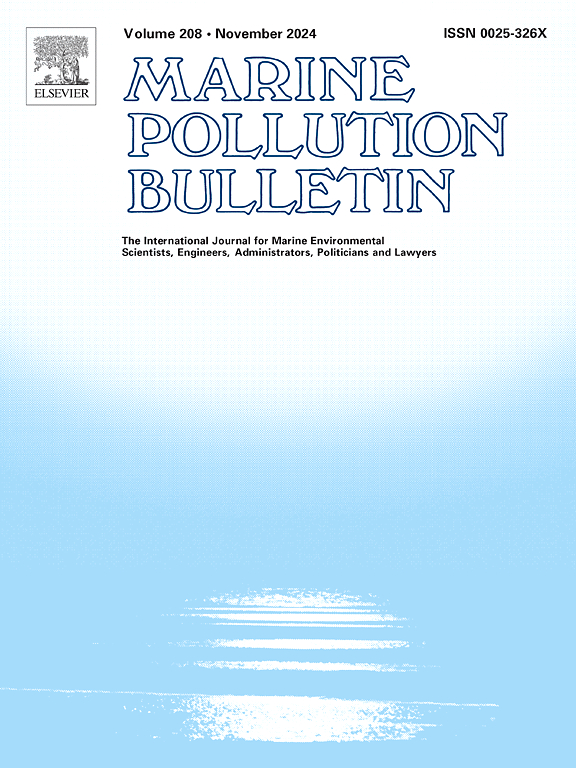Spatial–temporal dynamics of marine microorganisms in Kuroshio–Oyashio Extension
IF 5.3
3区 环境科学与生态学
Q1 ENVIRONMENTAL SCIENCES
引用次数: 0
Abstract
Kuroshio–Oyashio Extension (KOE) region is an ideal natural laboratory for investigating microbial community dynamics due to its frequent nutrient exchanges. However, comprehensive spatiotemporal investigations of microbial communities in this region remain limited. We conducted a systematic research examining microbial community variations across space and time through integrated physicochemical analysis and high–throughput sequencing of 54 surface water samples collected from 33 stations during three consecutive summer seasons (2021−2023). The results demonstrated an increasing trend in species richness from Cold Water Area (CWA) to Warm Water Area (WWA), while species diversity showed no significant spatiotemporal trends. The nMDS analysis indicated that the microbial communities in mixed area were more similar to those in WWA during 2022 and 2023. There were significant spatial and temporal differences in the structure and composition of microbial communities, with spatial differences being particularly pronounced. Proteobacteria (range: 61.64%–76.39%), Bacteroidota (range: 8.09%–10.74%), Cyanobacteria (range: 5.51%–19.05%), and Verrucomicrobiota (range: 0.95%–7.24%) were the dominant phylum. Spatially and temporally, dominant genera such as Vibrio, Alteromonas, Pseudoalteromonas, Prochlorococcus_MIT9313, Alcanivorax, and Synechococcus_CC9902 exhibited dynamic shifts in abundance. Spearman correlation analysis and Mantel tests indicated that temperature, salinity, density and conductivity were key environmental factors. Co–occurrence network analysis showed that microbial interactions were dominated by positive correlations. The complex interplay of geographic location, environmental parameters, microbial interactions, and ocean current patterns collectively governed the microbial distribution within KOE region. This research significantly enhances our understanding of the mechanisms underlying microbial community construction and maintenance in KOE region.

黑潮-沽潮延伸区海洋微生物的时空动态
黑潮-溯潮延伸区(KOE)因其频繁的养分交换而成为研究微生物群落动态的理想天然实验室。然而,对该地区微生物群落的全面时空调查仍然有限。通过综合物理化学分析和高通量测序,研究了连续三个夏季(2021 - 2023)从33个站点采集的54份地表水样本的微生物群落在空间和时间上的变化。结果表明,从冷水区到暖水区,物种丰富度呈增加趋势,而物种多样性无明显的时空变化趋势。nMDS分析表明,2022年和2023年混合区微生物群落与WWA区更接近。微生物群落的结构和组成存在显著的时空差异,其中空间差异尤为明显。变形菌门(61.64% ~ 76.39%)、拟杆菌门(8.09% ~ 10.74%)、蓝藻门(5.51% ~ 19.05%)和疣菌门(0.95% ~ 7.24%)为优势门。在时空上,优势属Vibrio、Alteromonas、Pseudoalteromonas、Prochlorococcus_MIT9313、Alcanivorax和Synechococcus_CC9902的丰度呈现动态变化。Spearman相关分析和Mantel试验表明,温度、盐度、密度和电导率是关键环境因素。共现网络分析表明,微生物相互作用以正相关为主。地理位置、环境参数、微生物相互作用和洋流模式的复杂相互作用共同决定了KOE地区微生物的分布。本研究有助于我们对KOE地区微生物群落构建和维持机制的理解。
本文章由计算机程序翻译,如有差异,请以英文原文为准。
求助全文
约1分钟内获得全文
求助全文
来源期刊

Marine pollution bulletin
环境科学-海洋与淡水生物学
CiteScore
10.20
自引率
15.50%
发文量
1077
审稿时长
68 days
期刊介绍:
Marine Pollution Bulletin is concerned with the rational use of maritime and marine resources in estuaries, the seas and oceans, as well as with documenting marine pollution and introducing new forms of measurement and analysis. A wide range of topics are discussed as news, comment, reviews and research reports, not only on effluent disposal and pollution control, but also on the management, economic aspects and protection of the marine environment in general.
 求助内容:
求助内容: 应助结果提醒方式:
应助结果提醒方式:


